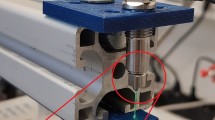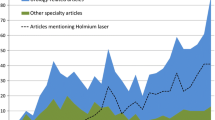Abstract
Purpose
To evaluate and assess the impact of noise hazard during laser lithotripsy using the gold standard holmium:YAG laser and the novel thulium fiber laser (TFL).
Methods
Intraoperative noise measurements were obtained during ureteroscopy and laser lithotripsy from cases using both TFL and holmium laser. Readings were obtained from three key times: prior to laser activation, with the laser on but idle, and during laser activation. Questionnaires were circulated postoperatively to operating room staff regarding the effort required to perform tasks, concentrate, and communicate during the surgery.
Results
Noise levels were compared from 16 TFL and 15 holmium laser lithotripsy cases from 11/2020 to 5/2021. Significantly higher noise levels were recorded during holmium lithotripsy, with a mean of 3.1 dB and 4.3 dB higher noise with the device idle and device active, respectively. When compared to baseline noise with the device off, the holmium laser had a significant rise in recorded dB where the TFL had no statistically significant rise in noise over baseline once the laser was turned on. Operating room team members rated the noise level lower and the level of effort required for concentration, communication, and task completion lower with the TFL.
Conclusions
The TFL produces 3.1 to 4.3 dB less noise than the standard holmium laser, which, because of the logarithmic nature of the dB scale, translates into less than one half the overall noise energy. There was also less effort required by operating room staff to complete critical tasks during the quieter TFL cases.

Similar content being viewed by others
Availability of data and materials
Data are available upon request.
Code availability
Not applicable.
References
Engelmann CR et al (2014) A noise-reduction program in a pediatric operation theatre is associated with surgeon’s benefits and a reduced rate of complications: a prospective controlled clinical trial. Ann Surg 259(5):1025–1033
Health UDoLOSa, A. [cited 2020 September 14]; Available from: www.osha.gov.
Hodge B, Thompson JF (1990) Noise pollution in the operating theatre. Lancet 335(8694):891–894
Xu H et al (2017) Evaluation of noise hazard during the holmium laser enucleation of prostate. BMC Urol 17(1):71
Sevdalis N, Healey AN, Vincent CA (2007) Distracting communications in the operating theatre. J Eval Clin Pract 13(3):390–394
Kurmann A et al (2011) Adverse effect of noise in the operating theatre on surgical-site infection. Br J Surg 98(7):1021–1025
Kronenberg P, Traxer O (2019) The laser of the future: reality and expectations about the new thulium fiber laser-a systematic review. Transl Androl Urol 8(Suppl 4):S398–S417
Celestina M, Hrovat J, Kardous CA (2018) Smartphone-based sound level measurement apps: evaluation of compliance with international sound level meter standards. Appl Acoust 139:119–128
Soucy F et al (2008) Occupational noise exposure during endourologic procedures. J Endourol 22(8):1609–1611
Borg G (1990) Psychophysical scaling with applications in physical work and the perception of exertion. Scand J Work Environ Health 16:55–58
Larsby B et al (2005) Cognitive performance and perceived effort in speech processing tasks: effects of different noise backgrounds in normal-hearing and hearing-impaired subjects. Int J Audiol 44(3):131–143
Siegel M (2019) The risk of noise-induced hearing loss performing knee replacement surgery. Noise Health 21(102):183–188
Gil K et al (2020) Satisfaction or distraction: exposure to nonpreferred music may alter the learning curve for surgical trainees. J Surg Educ 77(6):1370–1376
Funding
No funding was used for this study.
Author information
Authors and Affiliations
Contributions
JM protocol/project development, data collection or management, data analysis, manuscript writing/editing. AC data collection or management, manuscript writing/editing. GN data collection or management, Manuscript writing/editing. JB protocol/project development, Manuscript writing/editing. KS protocol/project development, manuscript writing/editing.
Corresponding author
Ethics declarations
Conflict of interest
The authors declare they have no financial interests.
Ethical approval
Local Investigational Review Board approval was obtained prior to study initiation. Study was judged exempt from IRB review.
Consent to participate
Consent was obtained from all study participants.
Additional information
Publisher's Note
Springer Nature remains neutral with regard to jurisdictional claims in published maps and institutional affiliations.
Supplementary Information
Below is the link to the electronic supplementary material.
Rights and permissions
About this article
Cite this article
Moore, J., Chavez, A., Narang, G. et al. Operating room noise hazards during laser lithotripsy: a comparison between the thulium fiber and holmium laser platforms. World J Urol 40, 801–805 (2022). https://doi.org/10.1007/s00345-021-03897-x
Received:
Accepted:
Published:
Issue Date:
DOI: https://doi.org/10.1007/s00345-021-03897-x




